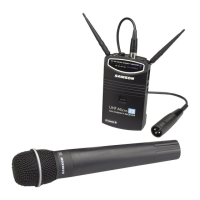8
Guided Tour - M32
8: Antennas (A and B) - The antenna
mountings allow full rotation for optimum
placement. In normal operation, both
antennas should be placed in a vertical
position. Both antennas can be folded
inward for convenience when transporting
the M32. See the “Setting Up and Using
the Micro 32 System” section on page 12
in this manual for more information.
9: DC input - This jack will accept a DC input voltage of 6 - 13 volts (inner connection [tip]
positive, outer connection [sleeve] ground) from your video camera, if available. Connect
the optional Samson AC300R adapter here to charge a rechargeable 9-volt Ni-Cad battery.
10: Unbalanced output* - Use this unbalanced (1K Ohm max.) 1/8" (3.5 mm) mini-phone
jack when connecting the M32 to consumer (-10) audio equipment. Wiring is as follows:
tip hot, sleeve ground. If your video camera has stereo audio inputs, you’ll need to use a
Y-adapter that has a 1/8" (3.5 mm) mini-phone plug at one end and dual male RCA-type
plugs at the other end.
11: Audio Output Level switch - Sets the audio output level of both the balanced and
unbalanced outputs (see #10 above and #14 below) to -30 dBm (mic level), -20 dBm, or
-10 dBm (line level). See the “Setting Up and Using the Micro 32 System” section on page
12 in this manual for more information.
12: Level control - This knob sets the
level of the audio signal being sent to
the headphones output (see #13
below).
13: Headphones output - Connect a
stereo headphone to this standard
1/8" (3.5 mm) mini-phone jack in order
to monitor the signal being output by the M32. We recommend the use of 30 ohm
headphones. The level of the headphone signal can be set by adjusting the Level control
(see #12 above). Maximum output is 240 mW @ 30 ohms).
14: Balanced output* - Use this electronically balanced low impedance (600 Ohm)
mini-XLR jack when connecting the M32 to professional (+4) audio equipment. Pin wiring
is as follows: Pin 1 ground, Pin 2 high (hot), and Pin 3 low (cold).
15: Meter switch - This three-position switch determines the function of the M32 meter
(see #2 on the previous page). In the left “RF” position, the meter indicates the strength of
the incoming RF signal. In the center “BATTERY” position, the meter indicates relative
battery power, showing whether the installed battery is at low (red), mid (yellow) or high
(green) strength. (Note: When the red “low” indicator lights, performance is degraded and
the battery needs to be replaced). In the right “OFF” position, the meter is disabled
altogether, thus conserving battery power.
* If required, both the unbalanced and balanced outputs can be used simultaneously.

